Tom Bartlett
Various articles that don't form part of a specific series.
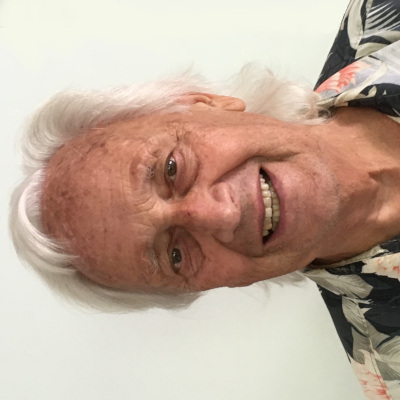
SIR
REDVERS HENRY BULLER VC, GCB, GCMG
[1839-1908]
Redvers Buller was born on 7th December 1839 at Downes, Crediton, the son of James Wentworth Buller, MP. One could say he was born with a silver spoon in his mouth, and once he had completed his schooling at Eton in 1858, he was commissioned into the King's Royal Rifle Corps, 60th Rifles.
The battles and wars he served in are far too numerous to mention here but the main ones were the Zulu War of 1879, for which he was awarded the Victoria Cross for bravery under fire, and following his involvement with the First Boer War of 1881 and as Head of Intelligence in the Egypt Campaign in 1882 he was knighted. That year he married Audrey, daughter of the f4th Marquess Townshend and later in the year was sent to the Sudan as Commander of an infantry brigade. In 1885, having commanded a successful expedition to relieve General Gordon, he was promoted to Major General.
In 1899 he w-as sent as Commander of the Natal Field Force on the outbreak of the Second Boer War. Following several defeats and concerns about his performance, in 1900 Lord Roberts replaced him as overall Commander in South Africa.
General Buller was very popular amongst the public in England and upon his return from South Africa was given a triumphal reception and many public celebrations. Sadly, in October 1901 he was asked to resign but refused and was dismissed on half pay. On 27th July 1904, General Buller gave a speech at the Inauguration Ceremony of Ilfracombe's new water supply when several other dignitaries were present, including Lord Ebrington, Lord Clifford, local MP E.J. Soares, and Council Chairman J.C. Clarke.


Throughout the West Country there were public expressions of sympathy for him. Indeed, in 1905, by public subscription, a notable statue of General Buller astride his horse was erected in Exeter, on the road leading out to Crediton.
Despite being offered a parliamentary seat when the Liberals returned to power in 1905, he turned it down in favour of peaceful retirement at his family seat Downes House, Downes, Crediton, where on the 2nd June 1908 he died. He was buried at the Holy Cross Churchyard, Crediton and his funeral must have been one of the largest ever held in Devon, as is shown by the many postcards published at the time.

Tom
Bartlett
Tower Cottage
44
JOHN WILLIAM GARRATT
[1865-1946]
Many of the photographic postcards that I've used to
illustrate my 'Old Berrynarbor' articles were the work of John William Garratt.
He was born on

Station Road, Ashley Down, Bristol
We can assume that Garratt lived with his parents, probably
in
John and Mary Jane moved to 'Stepleton View',
- 1898 Alfred Gregory
- 1899-1902 John William Garratt
- 1903-1904 John William Garratt, Artist
- 1905-1947 *John William Garratt, Photographer
* As already stated, Garratt died in October
1946, so the entry was not amended!

Horfield Barracks, Bristol
Their daughter, Alice Mary, was born on
Garratt has left a permanent photographic record and is known
to have taken and published approximately:
- 1800 postcards of the Bristol area
- 130 postcards of Cliff College, Calver, Sheffield
- 180 postcards of Berrynarbor, Devon
- 50 postcards of Bath
- 12 postcards of Saltash
- 6 postcards of Ilfracombe and 6 postcards of Woolacombe

Cliton Park, Bristol
In my collection I have a single six-view postcard of
Bedruthan Steps,
Garratt was a master at composing his photographs always
attempting to include children and adults.
We should remember that in those early days, he had to get participants
to stand absolutely still for up to two minutes whilst he took the photograph
on large, glass plates - no rolls of film or digital cameras in those days!
I must thank the late Alan Richardson for obtaining copies of
various Birth, Marriage and Death Certificates for John William Garratt.
Tom
Bartlett
Tower Cottage
36
THE FIRST
Many of us would imagine that the first
holiday camp would be one of those opened by Billy Butlin,
who was later knighted by the Queen to become Sir Billy Butlin,
but they would be mistaken.
In truth, Joseph Cunningham, a
successful flour dealer and baker from
I found this information as a result of
purchasing, through e-Bay, a quantity of
Tom Bartlett
Tower Cottage, September 2009


13
OLD BERRYNARBOR -
VIEW 112
'Berrinarbor'
A.H.
Hawke of Helston,

'Arrived about
Those of you who have been
reading my articles for some time will remember that in View 65 I wrote all
about the fire at Bessemer Thatch on the 5th May 1937, when all the thatched
roof and much of the house was destroyed.
At that time it was owned by Canon Jolly and the damage was estimated at
nearly £1,000. It was said that the
fire had been caused by a spark from a nearby chimney. Canon Jolly remained the owner right up
until his death in 1972.
Alfred
Herbert Hawke was a well-known and highly acclaimed photographer and postcard
publisher. He carried out his business
from a studio and shop in
Tom Bartlett
Tower Cottage,
March 2008
e-mail: tomandinge40@gmail.com
41
DOES ANYONE KNOW?
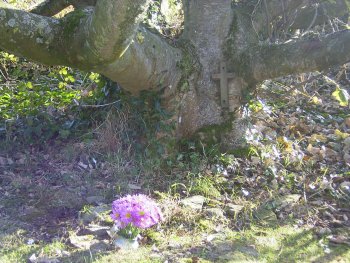
My thanks to Jenny Taylor whose e-mail from her home in France gave clues sufficient to set me on the path to finding out the facts behind the small cross memorial on the coastal footpath near Widmouth House. My thanks also to Sylvia and Cecil Hancock, and to Marie Chugg.
Marie lived at Widmouth for 27 years and the cross is in memory of her mother, Mrs. Madeline Leng, and her uncle Mr. Leonard Elderfield, both of whom spent happy times at Widmouth. Marie, who has very happy memories of times they all spent there, regularly places flowers under the tree. Marie's son, Paul, still lives in Ilfracombe.
Once again my thanks to all concerned for solving the mystery.
Tom Bartlett
January 2006
25
DOES ANYONE KNOW? This photograph was taken on the short but strenuous footpath walk from Watermouth Cove to the Coast Guard Houses. We have often walked this particular path and noticed fresh flowers placed near the cross, which is just after the footpath style near Widemouth House. I wonder if anyone can inform me why, when and in whose memory the cross was placed there. On our walk with Colin and Doreen on Sunday, 20th November, Inge was the first to spot a seal surfacing and feeding off the headland at the entrance to Watermouth Harbour. My thanks to Colin for taking the photograph at my request when my camera stopped working due to a low battery! I do hope someone can throw some light on the memorial. Tom Bartlett

37
BERRYNARBOR WAR MEMORIAL
With Remembrance Sunday just past, I though the two cards I have just added to my Berrynarbor Collection might be of interest. The first [below], which shows our War Memorial in the Churchyard with wreaths and a laurel-leaf crown, must have been taken around 1919-23, or shortly after its placing there.

The inscription reads:
TO THE UNFADING MEMORY OF OUR FALLEN WHO DIED FOR US
1914-1918
ALBERT TRUMP - ARTHUR J. SNELL - ALBERT LATHAM - SAMUEL TRUMP - WILLIAM HUXTABLE
SIDNEY W. TOMS - ALBERT J. SNELL - HERBERT E. RICHARDSON
St. John XV.13
Beyond the memorial can be seen part of the roof of Dormer House, now Miss Muffet's. The only difference in the second card, is that the letters M. M. [Military Medal] have been added after Arthur Snell's name.
We can be proud that, unlike Combe Martin, after the last War, the following inscription was placed on the north facing plinth:
ALSO OF THE FALLEN 1939-1945
JANE MALCOLM - ERIC ZAPLETAL - PETER MEADOWS - TREVOR MEADOWS
PATk. THIRKELL, D.F.M. - RAYMOND BROOKMAN
Perhaps someone out there could inform us where, when and how these last six parishioners, including a lady, lost their lives so tragically. How thankful we can all be that such wars are a thing of the past - and hopefully, long will they remain so!
Tom Bartlett - November 1994
13
GEORGE GEEN
2nd June Peace Celebrations

The picture shows both sides of the small silver medallion struck for Ilfracombe to commemorate the end of the Boer War in South Africa on 2nd June, 1902, which was presented to all the school children of Ilfracombe. This one was presented to George Geen who was born at Hele Bay in 1898 and started school when he was just three, at the Church School of St. Phillip and St. James. At the outbreak of the First World War, George joined the Devonshire Regiment and was sent to fight in France. Upon his return he came to live in Berrynarbor where he spent all his working life.
George carried out farm work and following his marriage to Hilda Toms at St. Peter's Church in 1923, they lived on Hagginton Hill.
In the late 1920's George left farming to work on the Ilfracombe to Barnstaple Railway Line, involved with track maintenance until the Depression and General Strike of the early 1930's. From the late 1930's, he obtained employment with the Barnstaple Rural District Council as a Roadman, dealing with road repairs and maintenance; he was called to assist with the restoration of Lynmouth after the tragic flood in August 1952. George retired in 1963.
In the early 1970's, he and Hilda moved to Combe Martin. Hilda died in 1978 and George some 12 years later in 1990, and their ashes are buried in St. Peter's Churchyard.
My thanks to their daughter, Mrs. Greta Harris, who now lives in Sudbury in Middlesex, for this information.
Tom Bartlett
17
WINTER VISITORS
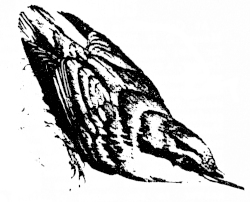
This winter at Tower Cottage we have often had a nuthatch at the peanut feeder beside our bedroom window. Generally it flies off in the direction of Old Court. Sadly, we have not had any woodpeckers or squirrels, but there have been robins, wrens, blue, great and coal tits, sparrows, thrushes, blackbirds and collar doves.
Turning out old items at Ilfracombe Museum recently, I came across the following list of Local Bird Names and thought it might be of interest to "zum of d'en local folks"!
AKKET - Seagull
BLUEBIRD - Fieldfare
BLUEHAWK - Peregrine Falcon
BULLIE - Bullfinch
CRACKIE - Wren
CRANE - Heron
DABCHICK - Dipper
DADFINCH - Chaffinch
DIPCHICK - Cormorant
DRISH - Thrush
FUZZCHITT - Stonechat
GLADIE - Yellowhammer
GOLDIE - Goldfinch
HEWHOLE - Green
or OOD AWL - Woodpecker
HOMESCRITCH - Mistle Thrush
KING MURRE - Great Auk
LINTIE - Linnet
LUNDY - PARROT Puffin
MURE - Razorbill
PERCHER - Herring Gull
PIGEON HAWK - Peregine
SEA PARROT - Puffin
BEANQUAKE - Corncrake
DISHWASHER - Wagtail
Tom Bartlett
21
HANNAH [ANNIE] LEWORTHY- 1897-1989
Hannah, better known as Annie, Leworthy was born on 20th June, 1897, at Manor House, Berrynarbor [in the room now known as the Men's Institute - it was much later, in 1913, that the Manor Hall was built], daughter of Alfie and Hannah [nee Rooke] Leworthy, who had been married on 2nd April 1887, when he was just 21 and she 22. Alfie's parents were John, a blacksmith of Berrynarbor, and Betsy [nee Willis] who probably came from Combe Martin. Hannah was the daughter of John and Ellen Rooke.
In the early 1900's, when Annie was still quite young, Manor House became so dilapidated that Squire Bassett offered her father and grandfather the use of Manor Cottage, which up to that time had been used as an additional residence by the Bassetts. Annie attended the village school until the 30th June, 1911, when at 14 she was allowed to leave, having obtained the necessary "Certificate of Leaving" signed by the Divisional Superintendent and the School Attendance Officer, Mr. Litten. [A copy of the Certificate is printed below]
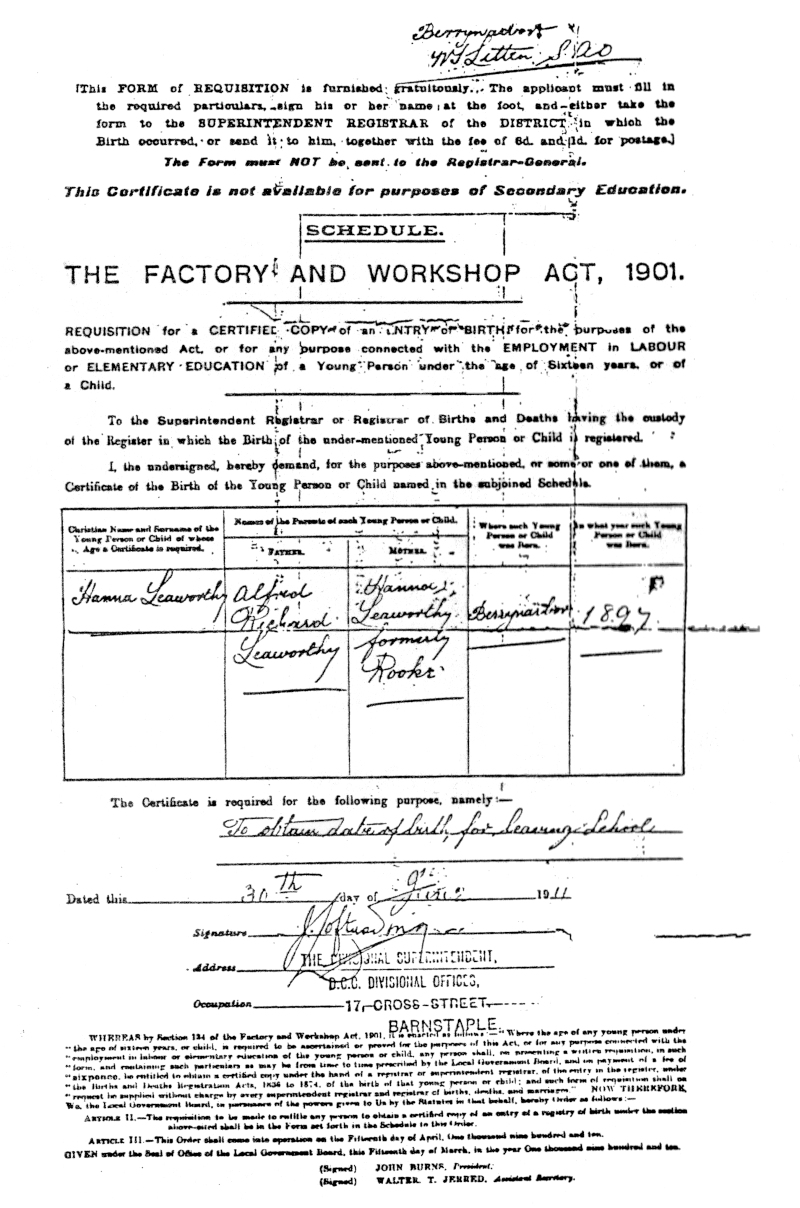
Annie first went to work for Mrs. Bassett at Watermouth Castle until at some time during the First World War her mother was taken sick and she returned to Manor Cottage to care for her and the rest of the family. Her mother died on 5th March 1923, aged 56; and Annie continued looking after her father and brother, Alfie, until he married and moved to Hagginton Hill.
Annie had two brothers, Bill, older than herself, and Alfie, younger. Bill was a gardener at Watermouth Castle but during the War joined the Royal Marine Light Infantry. On his return, he married and moved to Combe Martin. According to Lewis Smith, Alfie went to work for Devon County Council in 1916, at the age of 14, and helped with the building of the new road from Saw Mills to Sandy Cove in 1919-20. This had become necessary due to the landslide in January 1919 above Golden Cove taking the Old Coast Road and hundreds of tons of shale and limestone into the sea, 250 feet below. Alfie was well known as he drove one of the DCC large steam rollers all over North Devon; right up to County Gate, and was particularly proud of the fact that he had helped to roll the large runways and aprons at Chivenor Aerodrome. During the Second World War, he helped with the PLUTO project, at Watermouth and Berrynarbor, and rolled a large area of land to the side of Rose Cottage to enable the fuel tankers to turn round!
Annie was a regular attender at Church Services and was, for many years, a member of the Choir. She never married and thanks largely to her constant care, her father who worked most of his life as a gardener at Watermouth Castle - lived to the ripe old age of 87, dying on the 6th June, 1953.
It was about this time that 6 year old Jennifer Stuckey [Annie's great-niece] came to live with her at Manor Cottage, after Jennifer's mother, Lillian; had tragically died of leukaemia in 1952. Jennifer began school in the village and went on in the early '60's to Ilfracombe Grammar School; where she was Head Girl. She won a scholarship to Liverpool University and obtained a degree in Physical Education and English Literature. Following this she began teaching at Battle in Sussex, where she still lives today.
Annie had taken in one or two visitors to supplement their limited income and during the War had taken evacuees from London. When Jennifer left, Annie remained alone, except for her cat, at Manor Cottage. She would be one of the first customers at the butcher [then run by Reg and Betty Davis] and would always have her 'shillingsworth' of meat, including some liver for the cat. She never did get the hang of decimalisation and continued asking for her 'shillingsworth' right up until 1982, when through age and ill-health, she moved into Belmont Grange Old People's Home, where she remained until June 1989 when she transferred to Wilderbrook Nursing Home. She died on the 22nd September, 1989, at the age of 92.

Annie and her Family Outside Manor Cottage, c1907
Left to Right: ANNIE, Hannah [Annie] - Mother, Alfie - Father, Florrie - Sister [mother of Lillian], Alfie - Brother, Bill - Brother, Effie - Sister and Not known - probably a friend of Bill.
For a great deal of help with this article and the loan of pictures, my thanks to Annie's great- nephew, John Tossle, and his wife Hilary, who live at Manor Cottage with their daughter, Lara; also to Reg and Betty Davis and to Alf Stuckey of Ilfracombe. Once again, my apologies for any inaccuracies in this profile.
Tom Bartlett
23
FREDERICK JOHN DRAPER [UNCLE JACK]
"Uncle Jack", as he was known throughout the Village, was born during Queen Victoria's reign on 8th December, 1886, to John and Selina Draper [nee Richards] of Combe Martin. He died on the 21st February 1985, at the ripe old age of 98 in the Tyrell Hospital, Ilfracombe, his second visit - the first at the age of 5 when he lost the last 3 fingers on his left hand in a "chaffe Cutter".

L to R: Jock the Barber, Uncle Jack and Corny Burgess who had been deep into the caves above Broad Sands.
Jack attended school in Combe Martin, but at the age of 10, on the death of his father, he was put out to work at Girt Farm as a general labourer. He later became well known as a stone mason, general labourer and water diviner! On the 28th September, 1914, he married his first cousin, Florence May Draper, who was 21 and the daughter of William Draper of Berrynarbor. She had been in "service" at Beech Lee and their honeymoon lasted but one day, as Uncle Jack was drafted off to India with the 6th Devons, as a member of the Regimental Band playing the bombardon, and he spent the next 6 years out there.
On his return from India, he and Florrie lived in higher Combe Martin, but within a year or so, with Florrie suffering from asthma, they were advised to move and came to Berrynarbor first to Croft Lee and then "Ferndale, 94B" on 15th May, 1924. His first Driving Licence, No. D5890 [Motor Car Act 1903] was issued by D.C.C and lasted one year at a cost of 5/-! During the '20's and '30's he was a jobbing mason and also swept chimneys, taking his brushes with him in the sidecar of his belt-driven motorcycle! He was a keen member of the Church Bell Ringers and would travel with them all over the County to competitions.
During the Second World War he was in the Home Guard, and in addition to his normal work was employed as the Church Sexton, responsible for the digging and caring of the graves and maintenance of the Church, Rectory and paths. During this period, he also held a licence No. 72 from Devon Constabulary allowing him to store and use quantities of gelignite and detonators for blasting! Known locally as "Powder Monkey" he would be employed in blasting large rocks. He worked on the installation of the gas main to and in Combe Martin, built walls in Ilfracombe, and even worked on the installation of the railway engine turntable at Ilfracombe Station.
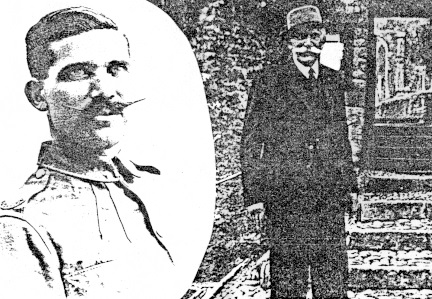
In 1955, at 65, Uncle Jack retired, giving his tools to one of his nephews. Moping at home and fed up with nothing to do, Florrie told him he should buy new tools and get back to work! He did, and continued to do so until he was 84 years young. Florrie died in 1955, shortly after his 'first' retirement. Uncle Jack smoked a pipe of 'baccy' until at the age of 84, he fell asleep with it lit and nearly set himself on fire - he hung his pipe up on the wall and never touched it again!
Uncle Jack was a very popular figure in the Village, well-liked by villagers and visitors alike. He was particularly proud of his continued maintenance of the church steps and cobbles and could often be seen making small repairs and talking to children, for whom he always had great affection.
To Jack's nephew, Ken Draper and his wife, my grateful thanks for their help with the information for this article and also for the loan of their photographs. Again I apologise for any inaccuracies. Can anyone help me with information or pictures of Miss Leaworthy?
Tom Bartlett
24
DAVID BERNARD GOODMAN [1917-1987]
Born and brought up in Greenwich, 'Dave' enlisted on the 2nd August 1932 with the Royal Engineering Corps at the Duke of York's Military School at Dover, having left school at the age of 15. He had an impeccable service record, remaining with the Engineers until his retirement, 25 years later, in July 1957, with the rank of Staff Sergeant.

Dave's first involvement with Berrynarbor came during the War when he came to Watermouth with the PLUTO project - Pipe Line Under the Ocean. The pipeline was laid across the Bristol Channel, from Wales to Watermouth Harbour, and finally up towards Mill Park, where the fuel lines ended and fuel oil originating in Wales was drawn off into road tankers for distribution. It was during this time that Dave met and married Vi Toms in St. Peter's Church. Based on the success of the Pluto project, a pipeline was laid across the English Channel to France, which assisted our troops after D Day, when Dave and his battalion were torpedoed and he and just a few comrades became the only survivors. His only son, Terry, was born in 1949 and attended our local school before going to Combe Martin. Following in his father's footsteps, Terry studied engineering and worked in Kuwait, but now lives locally with his wife and three children and has a very successful business in Barnstaple.
Upon leaving the Engineers, Dave spent some time at Liberty's in Regent Street, before returning to Berrynarbor in 1960. He then spent probably four of his happiest years teaching children to swim at the Ilfracombe Swimming Baths, which at that time were behind the Holiday Inn [llfracombe Hotel] both buildings having now been demolished. Leaving this job in 1964, he commenced employment with Mr. Norman in building and doing odd jobs around the village, but in the early '70's, he joined EDL Engineering, Where he remained until his retirement in 1984.
Dave Goodman served the Berrynarbor community unstintingly as a Parish Councillor from about 1970 until his sad death on the 3rd April, 1987. He must have been the Chairman of the Footpaths Committee for the majority of the time he spent on the Council, and his highlight was receiving an official invitation to the Buckingham Palace Garden Party during his year as Chairman of the Parish Council. Dave was a keen member of the local British Legion, and Remembrance Sunday was a very special day for him, when he would act as Standard Bearer - displaying his War medals - and more often than not, presented the Legion's wreath of poppies at the War Memorial just inside the church lych gate. An act he performed with great pride.
Dave often gave his time and energy to assist the youngsters of the village in sports, etc., and often acted as an informal "special constable".
He was always interested in gardening and originally tilled and grew flowers and vegetables on the plot of land beside the Manor Hall, and when it was converted into a children's playpark, he took over the large plot of land behind the Chapel, where he grew prize flowers and vegetables. His gardening gave him great pleasure.
Sadly, shortly after his retirement, illness struck Dave and for the next three years his health was very 'up and down' often with him having to fight for his breath.
Dave will always be remembered by the many visitors for his cheerfulness and willingness to help and speak to them, and he was sadly missed from the village centre.
Note : I again apologise for any inaccuracies in the above article, and would welcome any further information. I am now looking for information and any pictures/ photographs of "Uncle" Jack Draper, for a similar profile in the Christmas issue. Thanks .
Tom Bartlett
21
LEWIS SMITH
[1916-1989]
Lewis Smith was born on the 9th October, 1916 at Berry Mills [now known as Mill Park Camping Site - see picture], where his parents, Ernest and Edith Smith moved in 1904 when they were married. His father came from Braunton, but his mother was a Berrynarbor lass, and from the day they moved in, they used the large water mill to grind corn for local farmers and also sold corn and meal. The mill wheel was fed with water brought via a mill leat taken off the stream some distance beyond North Lee Farm, where his grandfather lived.
Lewis had an older brother, Park and a sister, Evelyn, and in October 1919 they all moved to the larger West Hagginton Farm. Lewis began to attend the village school when he was only six, but the long walk was too great for his then frail frame, so he left, restarting two years later.
At the age of twelve, he left the village school and spent the next four years at Braunton's Chaloner's School, boarding there from Sunday evening until Friday, when after school he would travel to West Hagginton Farm for the weekend at home. Leaving Chaloner's school in 1932, he worked with his father and brother at West Hagginton Farm until they sold up and moved back into the village in 1938.
On his 21st birthday, Lewis went up to Glasgow to visit Miss Ansley Sinden, his first sweetheart whom he had met several years earlier when she moved with her family to the new coastguard houses between Ilfracombe and Berrynarbor. He helped his father and the Combe Martin builder, Squires, knock down the old cottage they had bought and then to build their new house. He must have shown good promise as a builder, as he remained working for Squires of Combe Martin for the next twenty plus years, including the war years.
He met his wife, Vida, shortly after moving back into the village, when she was living in Berry Mills with her mother and step-father and their wedding took place at the Christian Brethren Assembly Hall, the High Street, Ilfracombe. Sadly, the marriage was not blessed with children. They lived together in Lee View right up until Vida's death in 1982. A few years later, finding Lee View too large, he sold up and after a brief stay at The Lodge, moved into Forge Cottage, just three doors up the road.
Lewis had taken an ever-increasing interest in St. Peter's Church and joined Len Bowden as a Church Warden around 1965, a position he retained until his death on Friday, 2nd June, 1989. He had been an active participant in the recent changes of the South Transept and its conversion into a Lady Chapel.
A note of particular sadness for him was that sometime after becoming a widower, he had found out that Ansley's husband had recently died and he wrote to her at Christmas inviting her down to visit him. Such is fate that just after Christmas he received a note from Ansley's sister-in-law to say that Ansley had had a stroke just before Christmas which had resulted in her death.
At mid-day on the bright and sunny Saturday, 10th June, the Church was almost filled to overflowing in honour of and respect for Lewis Smith.

Berrynarbor School c. 1924


|
1. Jack Hockridge |
9. Vera Dummett |
Note: For any inaccuracies in this Obituary, I offer my sincere apologies and would welcome any further information.
Tom Bartlett, Tower Cottage. July 1989
21